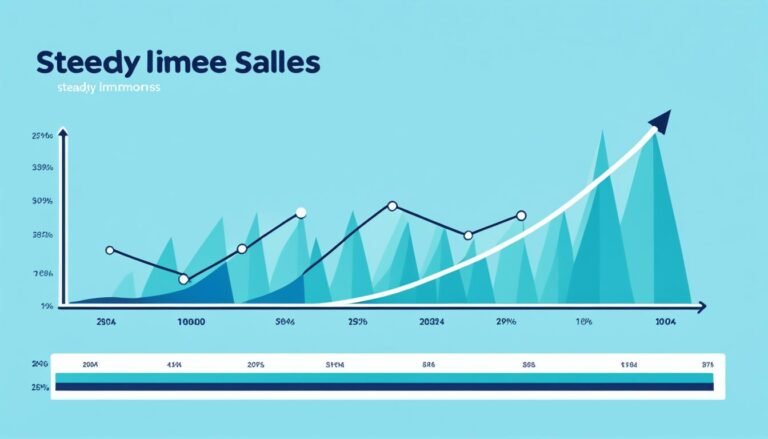Unlock Sales with Psychological Triggers in Selling
Navigating sales conversations requires an understanding of human psychology, particularly the instinct for self-preservation. By tapping into psychological triggers, such as the fear of loss and the desire for exclusivity, salespeople can increase their chances of success. Psychological triggers can be used to create a sense of urgency, establish credibility, and appeal to consumers’ emotions, ultimately leading to higher conversions and sales.
Key Takeaways:
- Employ persuasive selling techniques by leveraging psychological triggers.
- Utilize emotional selling tactics to appeal to consumers’ emotions.
- Tap into subconscious selling strategies to influence purchasing decisions.
- Understand buyer psychology and behavioral triggers in sales.
- Master persuasive communication techniques in selling.
Understanding the Risk-Averse Mindset in Sales
The human brain is wired to avoid loss and prioritize self-preservation. This risk-averse mindset is deeply ingrained in our subconscious and influences our decision-making process, including purchasing decisions. To be successful in sales, it’s crucial to understand and tap into this mindset to effectively persuade and influence prospects.
One key aspect of the risk-averse mindset is the fear of loss. People are more motivated to take action when they perceive the potential loss to be greater than the potential gain. By framing questions that highlight the negative consequences of not taking action, salespeople can tap into this fear and create a sense of personal urgency.
For example, instead of simply presenting the benefits of a product or service, asking questions like, “What do you stand to lose if you don’t take advantage of this opportunity?” can trigger prospects’ risk-averse mindset and compel them to consider the potential negative outcomes. This approach helps salespeople position their offerings as solutions to mitigate or eliminate these risks, fostering a sense of urgency and compelling prospects to take action.
Tapping into personal urgency
To tap into personal urgency effectively, salespeople need to understand their prospects’ pain points, aspirations, and goals. By identifying the specific fears and concerns that drive their prospects’ risk-averse mindset, salespeople can tailor their messaging and offers accordingly.
Additionally, salespeople can leverage personal anecdotes and real-life scenarios to make the potential loss more relatable and evocative. Sharing stories about missed opportunities or negative outcomes resulting from inaction can create an emotional connection and deepen prospects’ sense of personal urgency.
“What do you stand to lose if you don’t take advantage of this opportunity?”
This question forces prospects to confront the potential consequences of inaction, shifting their perspective from focusing solely on benefits to considering the risks of not making a decision. By aligning their offering with the prospect’s desire to avoid loss and prioritize self-preservation, salespeople can build a compelling case and increase their chances of closing the sale.
| Benefits of tapping into the risk-averse mindset in sales | Challenges of tapping into the risk-averse mindset in sales |
|---|---|
| Sense of personal urgency | Overcoming resistance to change |
| Increased credibility and trust | Addressing objections related to potential risks |
| Higher conversion rates | Identifying and understanding specific fears and concerns |
Note: This table provides an overview of the benefits and challenges associated with tapping into the risk-averse mindset in sales.
By recognizing and tapping into the risk-averse mindset, salespeople can leverage the fear of loss and the desire for self-preservation to drive action. By framing questions that stimulate personal urgency and addressing potential risks, salespeople can increase their credibility, build trust, and ultimately achieve higher conversion rates. Understanding and effectively engaging with the risk-averse mindset is a powerful tool in the sales arsenal.
Framing High-Stakes Questions for Deeper Conversations
In order to have more meaningful and impactful sales conversations, it is important for salespeople to move beyond surface-level questions. By leveraging data-backed insights, sales professionals can frame poignant, high-stakes questions that elicit genuine responses and allow them to uncover the true challenges and pain points of their prospects.
By focusing on the personal stakes and emphasizing the weight of responsibility, salespeople can initiate deeper and more actionable conversations with their prospects. These high-stakes questions create a sense of urgency and compel prospects to open up about their specific needs and concerns, providing valuable insights that can guide the sales process.
Here are some strategies to effectively frame high-stakes questions:
- Utilize research and data: Before engaging in a sales conversation, gather relevant data and research about the prospect and their industry. This will enable you to ask targeted questions that demonstrate your understanding and expertise.
- Focus on pain points: Identify the key pain points your product or service can address and develop questions that prompt prospects to articulate their challenges. Encourage them to delve deeper into the issues they are facing and how these challenges impact their business.
- Uncover the consequences of inaction: Highlight the potential negative outcomes or missed opportunities if the prospect chooses not to address their pain points. By emphasizing the risks and costs of inaction, you can create a compelling case for your solution.
- Ensure relevance and personalization: Tailor your questions to the specific needs and goals of each prospect. Use the insights you’ve gathered to pose questions that resonate with their unique circumstances, making the conversation more meaningful and engaging.
Asking high-stakes questions requires a combination of empathy, preparation, and the ability to navigate sensitive topics. By framing poignant questions that align with the prospect’s goals and challenges, salespeople can foster deeper connections and build trust, paving the way for successful sales conversations and ultimately, increased conversions.
Example of Framing High-Stakes Questions:
| Surface-level question: | Do you have any challenges with your current system? |
|---|---|
| Poignant, high-stakes question: | How has your current system’s lack of scalability affected your ability to meet growing customer demands, and what impact has this had on your revenue and market share? |
| Analysis: | The high-stakes question highlights the consequences of inaction by linking the current system’s limitations to specific negative outcomes. It prompts the prospect to reflect on the real impact of their challenges and provides valuable insights for the salesperson. |
By leveraging the power of high-stakes questions, salespeople can ignite deeper conversations that uncover critical information and create a stronger connection with prospects. These data-backed insights pave the way for more effective and persuasive sales interactions, ultimately leading to increased conversions and sales success.
Leveraging Social Proof and Authority in Sales
Social proof plays a vital role in building trust and credibility with potential customers. When people see that others have had positive experiences with a product or service, they are more likely to perceive it as reliable and trustworthy. This psychological trigger taps into the need for validation from others, and salespeople can leverage it to their advantage.
One powerful way to use social proof in sales is by showcasing customer testimonials, reviews, and ratings. These testimonials provide real-life examples and experiences that demonstrate the benefits and value of the product or service. By prominently displaying these testimonials on websites, salespeople can instill confidence in their prospects and alleviate any doubts or concerns they may have.
“I was hesitant to purchase the software at first, but after reading all the positive reviews and testimonials, I decided to give it a try. I’m so glad I did! It has transformed the way I manage my business.” – Jane Smith, satisfied customer
Another effective strategy is to leverage authority figures in the industry. This can be done by seeking endorsements from recognized experts, influencers, or renowned individuals who are respected and trusted by the target audience. When prospects see that authoritative figures endorse a product or service, it enhances the perception of credibility and establishes the seller as a trusted source of information.
For example, a salesperson selling skincare products can feature a quote from a renowned dermatologist endorsing the effectiveness of the product:
“As a dermatologist with over 20 years of experience, I highly recommend this skincare line. It uses scientifically-proven ingredients that deliver visible results.” – Dr. Sarah Johnson, renowned dermatologist
By leveraging social proof and authority figures in sales, salespeople can create a powerful impact on prospects. This not only increases the credibility and trustworthiness of the product or service but also influences purchase decisions in favor of the salesperson.
Key Takeaways:
- Social proof is a psychological trigger that taps into the need for validation from others.
- Customer testimonials, reviews, and ratings are effective ways to showcase social proof.
- Endorsements from authority figures in the industry enhance credibility and trust.
- Leveraging social proof and authority figures can positively influence purchase decisions.
The Power of Scarcity and Urgency in Sales
Creating a sense of scarcity and urgency can be a powerful strategy in sales. By leveraging scarcity triggers, time-limited offers, and exclusive deals, salespeople can tap into the fundamental human drive to seize opportunities and avoid the fear of missing out (FOMO). These psychological triggers create a sense of urgency, compelling customers to take immediate action and increasing conversions and sales.
When customers perceive that a product or service is scarce or in high demand, it triggers a fear of missing out and motivates them to act quickly. Limited availability and time-limited offers create a sense of urgency, driving customers to make a purchase decision before the opportunity disappears.
Exclusive deals and offers reserved for a select group of customers create an additional layer of exclusivity and desire. Customers are more likely to engage with a sales offer when they feel they have access to something unique or unavailable to others.
One effective way to utilize scarcity and urgency in sales is by highlighting the limited number of products available or the limited timeframe for taking advantage of an offer. Here’s an example:
“Only 10 units left at this exclusive discounted price! Don’t miss your chance to get the product before it’s gone.”
By creating a sense of scarcity and urgency, salespeople can overcome customer indecision and drive rapid purchase decisions. It appeals to customers’ desire to avoid missing out on valuable opportunities, reinforcing the need for immediate action.
Additionally, salespeople can use scarcity and urgency triggers strategically throughout the sales process, such as in follow-up emails or during negotiations, to maintain momentum and encourage timely actions from prospects.
Ultimately, scarcity and urgency triggers can significantly impact sales by increasing customer motivation, driving faster decision-making, and creating a sense of exclusivity. By leveraging these triggers, sales professionals can unlock the full potential of their sales opportunities and achieve greater success.
| Strategy | Description |
|---|---|
| Limited Time Offer | Offer a time-limited promotion with a clear end date to create urgency. |
| Exclusive Access | Provide exclusive deals or offers to a select group of customers to create a sense of exclusivity and desire. |
| Countdown Timer | Feature a visible countdown timer on your website or in marketing materials to highlight the remaining time to take advantage of an offer. |
| Limited Stock | Highlight limited quantities of a product or service to create a sense of scarcity and drive prompt action. |
| Early Bird Pricing | Offer discounted prices for early adopters or pre-orders to incentivize immediate buying decisions. |
Cognitive Triggers for Increased Conversions
In the world of sales, understanding the psychology of decision-making is crucial. By leveraging cognitive triggers, salespeople can strategically influence purchase decisions and increase conversions. Anchoring and framing techniques, loss aversion, and risk reversal strategies are powerful tools that tap into the way our minds process information and make choices.
Anchoring and framing involve setting reference points or providing context that influences customers’ perception of value and pricing. By presenting a higher-priced option first (anchoring), salespeople can create an anchor point that makes subsequent options appear more affordable. Framing involves presenting information in a way that highlights the positive aspects of a product or service.
Loss aversion is another cognitive trigger that can be harnessed in sales. People tend to prioritize avoiding losses rather than acquiring gains. By highlighting what customers stand to lose by not taking action, salespeople can create a sense of urgency and motivate them to make a purchase.
“Once you allow customers to imagine the pain of not having your product, they’re more likely to take action to avoid that pain.”
Risk reversal is a strategy that addresses customers’ concerns about potential risks or negative outcomes. By offering guarantees, warranties, or free trials, salespeople can reduce perceived risks and increase customers’ confidence in their purchase decision.
Tangible Benefits of Cognitive Triggers in Sales
By leveraging these cognitive triggers in sales, salespeople can achieve several key benefits:
- Increase Conversion Rates: By guiding customers towards desired outcomes and addressing objections preemptively, salespeople can significantly boost conversion rates. By understanding how customers think and make decisions, salespeople can tailor their approach and messaging to align with their cognitive biases.
- Build Customer Trust and Confidence: Cognitive triggers such as risk reversal and addressing loss aversion foster trust and confidence in customers. By reducing perceived risks and showcasing customer-centric policies, salespeople can create an environment where customers feel secure in their decision to purchase.
- Drive Customer Satisfaction and Loyalty: A well-executed sales process that incorporates cognitive triggers not only increases immediate conversions but also contributes to long-term customer satisfaction and loyalty. By effectively addressing customers’ needs and concerns, salespeople can build lasting relationships and foster repeat business and referrals.
By incorporating cognitive triggers into their sales strategies, salespeople can tap into the power of the human mind and significantly impact their sales outcomes. From anchoring and framing to loss aversion and risk reversal, these techniques enable salespeople to strategically influence customers’ decision-making process and drive increased conversions.
The Power of Familiarity and Beauty in Sales
When it comes to selling, familiarity and aesthetics play a significant role in capturing customers’ attention and influencing their purchasing decisions. People are naturally drawn to the familiar, finding comfort and trust in what they already know. By incorporating familiar triggers in the sales process, salespeople can tap into this universal attraction and create a sense of connection with their prospects.
One powerful way to leverage familiarity in sales is through the use of the Golden Rectangle in design. The Golden Rectangle is a mathematical ratio that is aesthetically pleasing to the human eye. It is often found in art, architecture, and design, and has been proven to elicit positive emotional responses in individuals. By incorporating the Golden Rectangle in their marketing materials, salespeople can create a visually appealing and harmonious experience for their prospects, thereby enhancing their perception of the product or service being offered.

The Golden Rectangle creates a sense of balance and proportion that resonates with customers on a subconscious level, making them more likely to engage with the sales content and ultimately make a purchase. This design principle can be applied to various elements, such as website layouts, product packaging, and promotional materials, to create a cohesive and aesthetically pleasing experience for the customer.
Furthermore, aesthetics in selling extend beyond design principles. The overall look and feel of a product or service can greatly influence customers’ perception of its quality and value. Salespeople should pay attention to details such as packaging, branding, and presentation to create a visually captivating experience for their prospects. By investing in high-quality visuals and appealing packaging, salespeople can enhance the perceived value of their offerings, making them more attractive to customers.
Incorporating familiar triggers in selling and utilizing aesthetic principles can have a profound impact on sales. By appealing to customers’ innate preferences for the familiar and utilizing the Golden Rectangle in design, salespeople can create a sense of familiarity and visual harmony that resonates with their prospects. This, in turn, enhances the perceived value and appeal of their offerings, ultimately influencing customers’ purchasing decisions.
Tapping into Emotional Triggers in Sales
Emotions are a driving force behind decision-making, and leveraging emotional triggers can have a significant impact on sales success. By incorporating storytelling techniques and creating personal connections with prospects, salespeople can tap into the power of emotions to strengthen engagement and motivation, ultimately leading to higher sales conversion rates.
Storytelling is a compelling way to connect with customers on an emotional level. By weaving narratives that resonate with their desires and aspirations, salespeople can create a sense of connection and relevance. Stories have the ability to evoke specific emotions and captivate the audience, making the sales message more memorable and persuasive.
To effectively tap into emotional triggers, salespeople should strive to understand their prospects’ needs, wants, and pain points. By empathizing with their challenges and aspirations, salespeople can establish a genuine connection that goes beyond the transactional nature of a sales conversation. This personal connection creates trust and builds rapport, increasing the likelihood of a successful sale.
“I can see how this product will fit perfectly into your lifestyle, fulfilling your desire for convenience and efficiency. Let me share a story about another customer who had the same aspirations and how our solution transformed their daily routine.”
By sharing success stories and testimonials from satisfied customers, salespeople can further strengthen the emotional connection with prospects. These stories serve as social proof, showcasing the positive impact of the product or service and reinforcing the prospect’s belief in its value. This validation from others triggers a sense of trust and confidence, making the purchasing decision easier for the prospect.
| Emotional Triggers in Sales | Benefits |
|---|---|
| Storytelling techniques | – Creates an emotional connection – Engages and captivates prospects – Makes the sales message memorable |
| Personal connections | – Builds trust and rapport – Establishes a genuine connection – Increases sales success |
| Sharing success stories | – Provides social proof – Reinforces value and credibility – Boosts prospect confidence |
By understanding and tapping into emotional triggers, salespeople can effectively influence sales outcomes. Through storytelling and personal connections, they can create a compelling narrative that resonates with prospects and drives them towards making a purchase. Building trust, establishing rapport, and providing social proof are all essential elements in leveraging emotional triggers to maximize sales success.
Leveraging FOMO and Anticipation in Sales
The fear of missing out (FOMO) and creating anticipation are powerful psychological triggers that can significantly impact sales. By strategically utilizing these triggers, salespeople can generate a sense of urgency and excitement among their prospects, ultimately driving increased conversions and sales.
Highlighting Limited Availability
One effective way to leverage FOMO is by highlighting the limited availability of a product or service. By emphasizing that the opportunity is exclusive and time-limited, salespeople can create a sense of urgency in their prospects. This can be achieved through techniques such as:
- Offering a limited number of products or slots
- Setting specific timeframes for promotions
- Using countdown timers to create a sense of ticking clock
By creating a perception of scarcity, salespeople tap into their prospects’ fear of missing out on a valuable opportunity, motivating them to take immediate action.
Building Anticipation for Upcoming Launches
Anticipation can be a potent psychological trigger that fuels customer engagement and drives sales. Salespeople can generate anticipation by building excitement and interest in upcoming product launches or events. Some effective strategies include:
- Teasing product features or benefits
- Revealing behind-the-scenes sneak peeks
- Offering exclusive pre-order opportunities
By creating a buzz and introducing an element of exclusivity, salespeople can make their prospects eagerly anticipate the release of a product or the start of an event. This anticipation motivates customers to be among the first to experience the offering, amplifying their desire to make a purchase.
“Creating a sense of urgency and building anticipation can significantly enhance sales. By leveraging the fear of missing out and generating excitement among prospects, salespeople can drive higher conversions and maximize their sales impact.”
Examples of Exclusive Pre-Order Opportunities
| Product | Expected Release Date | Exclusive Pre-Order Benefits |
|---|---|---|
| XYZ Smartphone | October 15, 20XX |
|
| ABC Fitness Program | January 1, 20XX |
|
By offering exclusive pre-order benefits, salespeople can create a sense of value and reward for early adopters. This strategy not only increases anticipation but also incentivizes prospects to make a purchase decision in advance.
A combination of fear of missing out (FOMO) and anticipation can be a game-changer in sales. By capitalizing on the limited availability of products and building excitement for upcoming launches, salespeople can tap into the psychological triggers that drive customer engagement and boost sales.
Leveraging Cognitive Biases in Persuasive Selling
Cognitive biases play a significant role in shaping our thought processes and decision-making. In the world of sales, understanding and utilizing these biases can be a powerful tool for persuasion. By tapping into cognitive biases such as confirmation bias, anchoring bias, and availability bias, salespeople can effectively influence purchase decisions and drive sales.
Confirmation Bias in Sales
Confirmation bias is a cognitive bias that refers to our tendency to seek out information that confirms our existing beliefs or opinions. In sales, leveraging confirmation bias involves aligning with customers’ existing beliefs and providing information that supports their decision-making process. By reinforcing customer confidence and validating their choices, salespeople can create a positive buying experience and increase the likelihood of a sale.
Anchoring Bias in Sales
Anchoring bias is the tendency to rely heavily on the first piece of information encountered when making decisions. In the context of sales, salespeople can leverage anchoring bias by strategically setting reference points that favor their offerings. By highlighting the value and benefits of their products or services early on, salespeople can establish a positive anchor and influence customers’ perception of value throughout the sales process.
Availability Bias in Sales
Availability bias refers to our tendency to rely on easily accessible or vivid information when making judgments. This bias can be leveraged in sales by making relevant information readily available to customers. By providing clear and compelling data, testimonials, or case studies, salespeople can tap into the availability bias and increase customers’ confidence in their offerings.
“By understanding and leveraging confirmation bias, anchoring bias, and availability bias, salespeople can effectively shape customers’ perceptions and increase the effectiveness of their sales efforts.”
| Cognitive Bias | Sales Application |
|---|---|
| Confirmation Bias | Align with customers’ beliefs and provide supporting information |
| Anchoring Bias | Set reference points to influence customers’ perception of value |
| Availability Bias | Provide easily accessible and compelling information |
By understanding and leveraging these cognitive biases, salespeople can enhance their persuasive abilities and drive meaningful connections with customers. These powerful techniques allow salespeople to effectively influence purchase decisions and increase sales.
Conclusion
Psychological triggers are powerful tools that salespeople can leverage to tap into human behavior and influence purchase decisions. By understanding and utilizing triggers such as the fear of loss, social proof, scarcity, and cognitive biases, sales professionals can enhance their persuasive abilities and maximize their sales impact.
Throughout the sales process, from creating awareness to closing the sale, applying psychological techniques can unlock the full potential of salespeople and drive higher conversions and sales. By creating a sense of urgency, establishing credibility through social proof, and leveraging scarcity, sales professionals can create a compelling environment that motivates prospects to take immediate action.
Additionally, by leveraging cognitive biases such as confirmation bias, anchoring bias, and availability bias, salespeople can effectively influence purchase decisions. Understanding the role that emotions play in decision-making and using techniques like storytelling and creating personal connections can further deepen engagement and drive sales success.
In conclusion, psychological triggers in selling provide salespeople with valuable insights into human behavior and purchasing patterns. By incorporating these triggers into their sales strategies, sales professionals can enhance their persuasion and influence, ultimately leading to higher conversions and increased sales.
Source Links
- https://wisernotify.com/blog/psychological-sales-triggers/
- https://www.linkedin.com/pulse/unlock-psychological-triggers-transform-your?trk=article-ssr-frontend-pulse_more-articles_related-content-card
- https://www.ecwid.com/blog/14-psychological-triggers-that-will-win-over-customers-and-increase-your-sales.html







